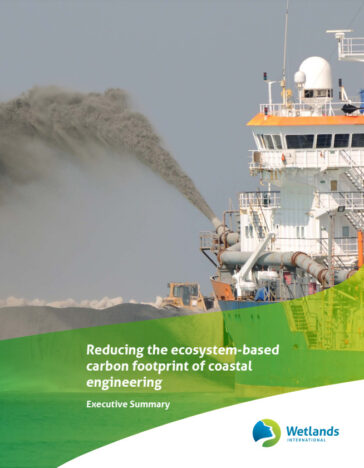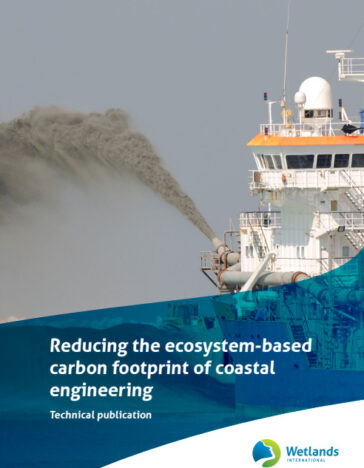
Reducing the ecosystem-based carbon footprint of coastal engineering
-
Coastal resilience
-
Coastal wetland conservation
-
Integrated delta management
Greenhouse gas emissions from coastal engineering do not only involve emissions from (dredging) vessels, but also from impacting sediments and coastal ecosystems. A new report by Wetlands International, developed with Witteveen+Bos and Deltares, outlines a simplified methodology for quantifying the ecosystem-based carbon footprint of coastal engineering projects. We also present potential options to reduce he carbon footprint, including through Nature-based Solutions.
With the report ‘‘Reducing the ecosystem based carbon footprint of coastal engineering’, the authors aim to facilitate discussions among those that commission, finance, design or implement projects towards more climate and ecosystem friendly coastal engineering
Carbon rich ecosystems
Coastal ecosystems such as mangroves, sea grass meadows, salt marshes and unvegetated intertidal wetlands contain sediments that are often rich in organic carbon. Mangroves for example, typically hold five times as much carbon as a similar area of rainforest, with most of the carbon stored within the sediment.
Interference with the carbon cycle of sediments and ecosystems
Coastal engineering projects like land reclamation, port development and coastal protection involve activities that interfere with the carbon cycle of sediments and coastal ecosystems, which can result in significant emissions, both on or off-site. This includes dredging and displacement of sediment, or activities that change the hydrological or sedimentation dynamics. Under some circumstances such disturbance causes previously sequestered carbon to be emitted as greenhouse gases.
New methodology to quantify carbon footprint
The new methodology presented in the report simplifies the complexity of organic carbon cycling in coastal systems. It distils the most relevant information that needs to be assessed in the form of a ‘sediment passport’, based on which one can zoom in on those engineering activities that influence key carbon stocks and processes. This in turn helps to identify potential ways to reduce emissions or sequester carbon.
Identifying practical nature-inclusive solutions to reduce emissions
The ecosystem-based footprint of coastal engineering projects can be reduced with the right adjustments. These include, among others the more carbon-benign handling of sediments during dredging, the beneficial use of dredging sludge; for instance for wetland creation and restoration, or land reclamation, and the careful release of dredged materials into the seascape. Moreover, there are also opportunities to enhance blue carbon sequestration by applying the so-called Building with Nature approach that integrates Nature Based Solutions into water and marine engineering practice.
Meeting net zero emission targets
To succeed in staying below 1.5 degree temperature rise as set out in the Paris Agreement, drastic reduction of emissions as well as removals of emissions are needed in all sectors. Ambitious targets have been adopted by governments and companies, including from the maritime and dredging sector, some of which have adopted voluntary net zero targets by 2030.
Current efforts to reduce the carbon footprint from coastal engineering focus mostly on the emissions related to the deployment of construction vessels and the use of materials such as concrete and steel. However, the impact of these projects on the carbon balance of coastal wetlands may be far greater.
Although the emissions arising from the burning of fossil fuels can be very thoroughly quantified, emissions from ecosystem and sediment disturbance have not, until now, been sufficiently accounted for. This study is a first step to address this discrepancy.
———————————————————————————————————
Femke Tonneijck, Programme Head Wetland Carbon at Wetlands International: “Understanding the ecosystem based carbon footprint of coastal engineering opens the opportunity to address a potentially vast source of emissions, while sequestering blue carbon through coastal wetland restoration”.
Martine Kox, Specialist subsurface and groundwater quality at Deltares: “This study shows the importance of quantifying potential emissions from the sediment itself, in addition to emissions from fossil fuels.”
Rob Nieuwkamer, Project Lead Explorations at Witteveen+Bos: “With regard to greenhouse gases: it is time to shift focus from the emissions of equipment to the impact of projects”.
———————————————————————————————————
Side event recordings UN Oceans Conference 2022
Watch the side event that we organised at the UN Oceans Conference on 30 June 2022 in which we presented the report and facilitated a discussion with Daan Rijks (Tender Manager and Business Development at Boskalis), Brenden Jongman (Nature-Based Solutions Program Lead at World Bank) and Paul Erftemeijer (Principal Marine Scientist) on the opportunities for the water sector and investors to use the new methodology as a step towards climate and ecosystem friendly coastal engineering.



